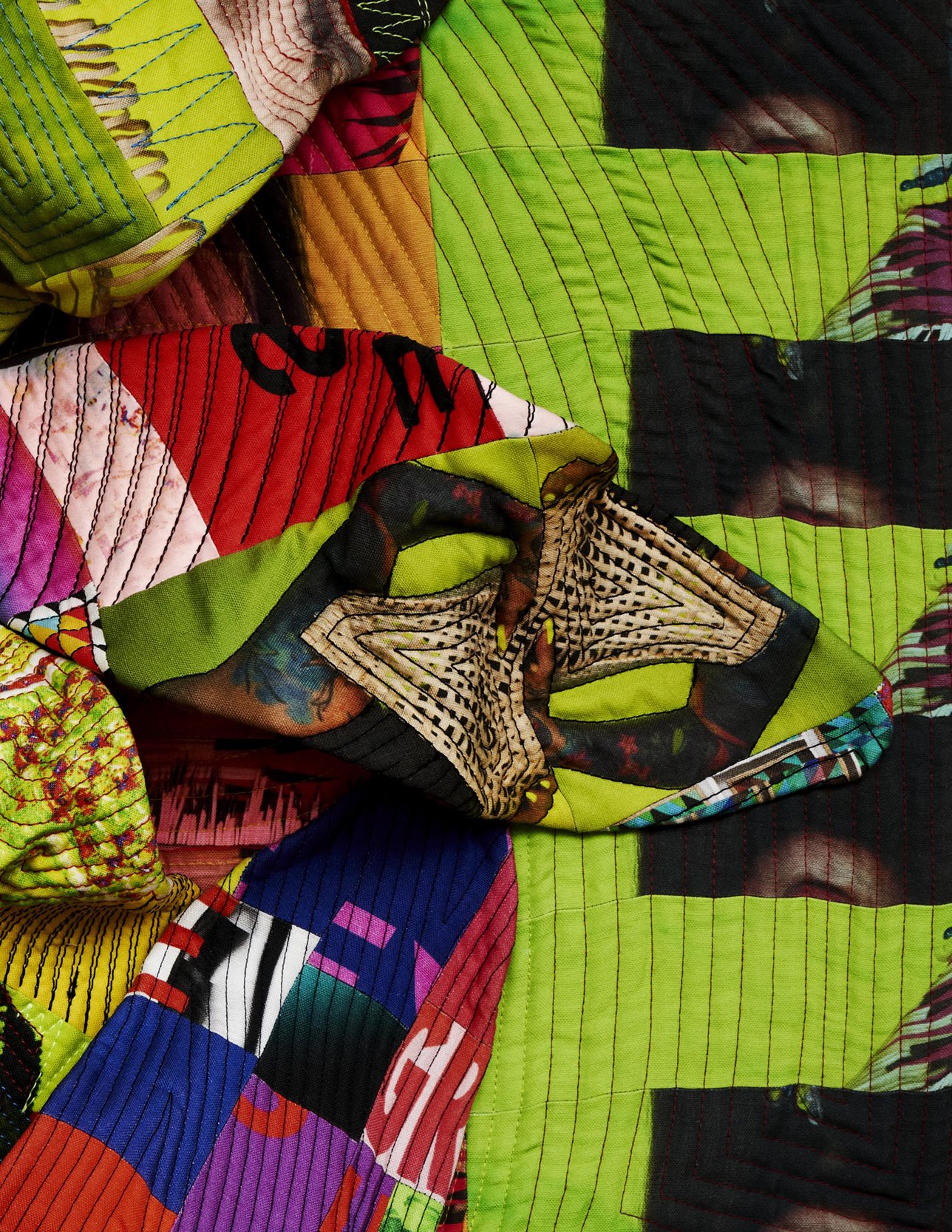Words Daniel Fuller Photography Carlton Davis
Originally published in No 13
Artist Jeffrey Gibson will represent the U.S. at the Venice Biennale in 2024, the first Indigenous artist to have a solo exhibition in the U.S Pavilion at the international art event. Gibson wrapped up in His Love is Deep, 2021. Power Full Because We Are Different, 2020.
There is visceral energy as six performers, some trained and others not, move to a procession of throbbing percussions. The first scene shows a drummer dragging his fingers across the head of a drum, pulling out a tormented droning sound. The utilitarian drum is a deer hide stretched taut over a bucket and painted with a bright eight-pointed star pattern containing a blocky-lettered proclamation: Time for Change.
Shot during 2020 summer's national civil unrest, the film was mainly taken at the rural sculpture sanctuary Art Omi, where it was exhibited in fall of 2021. The woods, the water, the downed trees and the tall grass feel as though they are worlds away, yet you can still hear the rumbles from the drums and the megaphone mumbles from the protests. The dancers are cloaked in garments constructed of offcut fragments of Gibson's old text pieces. Putting on these heavy pieces is transformative, but it's also a double-edged sword. The boldness of the text makes their attire feel almost armor-like, protecting them yet also weighing them down, restricting the dancers’ total freedom of movement: their second skin as another constraint. The end credits reveal that additional audio was recorded at the Black Trans Lives March, NYC, in September 2020. There is something compelling about the movement in Gibson's film in that, in each performance, the dancer takes a dramatic pause as their arms and hands briefly frame their face. The sentiment is palpable: it is a silent shout imploring that we stop and acknowledge the violence inflicted on trans and non-binary people.
Mixed glass and stone beads, acrylic paint on canvas, a work in progress for an upcoming exhibit.
The exhibition also featured two large-scale quilt works. Historically, quilts were conceived out of necessity. Quilts provide warmth, community gathering, and family stories added to and passed down through generations. Both of Gibson's grandmothers were quilters. He has sewn some form of textile since his teenage years, yet he never found fabric that was personal to him. But on seeing the seminal exhibition The Quilts of Gee's Bend, at the Whitney Museum of American Art, in 2002, he took notice that they were cutting up old clothing and other readily available fabrics. As part of a 2018 commission by the National Portrait Gallery, Washington, he wrote 50 texts that were printed onto fabric and then made into garments. Making the most of the offcuts and fabric scraps from that production, each revealing past moments from his practice, he thought, “Now I have a fabric that is truly mine.” Born anew as quilts, these stitched assemblages represent fifteen years of his own personal iconography. They rejoice in their timelessness and represent the power of the community of collaborators that gave them life.
These works exemplify much of Gibson's practice, where he so often acts as a platform, a convener, a loudspeaker for many other voices. For one of his first NYC solo exhibitions at PARTICIPANT INC., in 2012, he commissioned several traditional Indigenous artists to incorporate their work into his own sculpture and collage. Despite the craftsmanship, their drums, quilts, beadwork, engravings and personal accounts were often left out of “Fine Arts” discussions and were instead seen as anthropological artifacts from our deepest history. Now and forever, those artists from 2012, and the dancers wearing the garments in 2020, are all members of Gibson's extended community.
Sculpture in progress. Acrylic, felt, steel armature, artificial sinew, glass beads and nylon fringe.
Full circle, Jeffrey Gibson is an artist based in Germantown, NY, who fuses influences from pop music, fashion, literature, material culture, history and his own heritage of being a member of the Mississippi Band of Choctaw Indians, and of Cherokee descent. His work is frequently about reevaluating modernist artistic strategies, finding the balance between deeply rooted worlds: art and craft, art and commercial commodities, art and anthropological artifact, visible and invisible, kitsch and pop, male and female, simultaneously considering traditional techniques and references to form works today that confront the absences of those left behind — all so we can get to the innovations and new iterations of those traditions for tomorrow.
Detail of quilted, artist-designed fabric, a work in progress for an upcoming 2023 exhibit.
Another garment in progress of artist-designed fabric. Acrylic felt, canvas and polyester chainette fringe.
During summer of 2020 many artworld conversations around Black Lives Matter shifted to make room for Native and Indigenous artists like Wendy Red Star, Sky Hopinka, Raven Chacon, Postcommodity, Rose B. Simpson, Ishi Glinsky, New Red Order, and others, who are joining Gibson as big artworld stars. But that list is so small and severely incomplete. It’s hard enough to make it to the table as an artist, to be seen, and the artworld, like the larger one, is full of confusion and inequity. My words do not fit my admiration for Gibson's new book project, which is entirely self-initiated and self-published. As he phrased it, "Ultimately, it's on us to make sure that we remain present. I don't think there's any historical proof that, if we leave it up to other people, we will continue to be included. So, we're asking everybody within these smaller communities to name those we should be looking for: How do we expand this list?"
Daniel Fuller is a curator and writer based in Atlanta, Georgia. @fuller315 Carlton Davis is a regular contributor to UD and is represented by CLM-Agency.com @carltond







